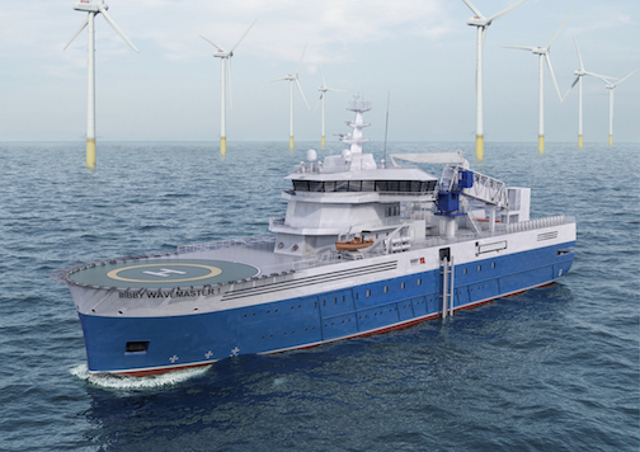On 15 January, Bibby Marine Services Limited, part of Bibby Line Group, signed a contract with the Damen Shipyards Group for delivery of its first Service Operations Vessel (SOV) with walk-to-work access. The vessel, Bibby WaveMaster 1, will undertake offshore wind project work in the North Sea. It is the first vessel purpose-built for the transfer and accommodation of offshore personnel and aims to maximise working time and staff retention. The design guarantees fast, safe and comfortable access to turbines, at lower cost, up to 80% of the time, including in worst case scenario Central North Sea conditions, resulting in a vessel capable of providing access up to 3.1 metre Hs.

In line with wind farms being constructed farther from shore, the SOV with walk-to-work access is able to remain at sea for periods up to one month. Accommodation is provided on board for up to 45 turbine maintenance personnel and 15 crew members.
Damen Business Development Manager Peter Robert described the thinking behind the concept, saying:
“This is much more than just a vessel – it is a total access and accommodation solution. The development of this vessel has started with a blank sheet of paper, as opposed to being an evolved version of an existing design. It has been tailored specifically to the needs of the offshore wind industry. This is the first time that a wind farm operations and maintenance vessel has been designed exclusively for this purpose. Great care has been taken, over 2 years of development, to ensure suitability to the tasks for which it is designed.
“As a result, the vessel will ensure the safety and comfort of all on board for increased workability. This, in combination with other design features aiming at optimal workflow, ensures that the Service Operations Vessel offers a revolutionary performance in terms of cost-efficiency."
The attention to detail can be seen throughout the design. For example, the hull, at 90 metres, is longer than that of a conventional platform supply vessel and the bow section has been lowered by 1.5 metres to create a V-shape. This feature offers significantly reduced slamming and facilitates inclusion and improved offshore operation of the bow thrusters.
The aft ship has been adapted specifically to the tasks that the vessel is designed for, including stern to waves operations. The most pronounced features that have been included are the strong V-shape in the frames in the aft ship to reduce the slamming occurrence and loads and the concentration of volume in the mid-ship region to achieve a slender aft ship. Both features should make stern to weather operations more comfortable than on a common PSV design.
Comfort onboard stems also from ergonomic design application, which sees interior spaces grouped together into similar task areas. This not only separates ‘clean’ and ‘dirty’ tasks, but ensures short lines of communication and smooth workflow. The accommodation has been placed midships for additional comfort – the location reducing vertical acceleration by as much as 15%.
Efficiency is another key feature. The design includes a diesel-electric main propulsion system, which powers twin azimuth thrusters. Thanks to careful development, the vessel requires less installed power than a conventional PSV. This results from two factors – a symmetrical wind profile and use of a four split main switchboard.
Mr Robert: “The symmetric profile is created by locating the superstructure amidships instead of bow mounted. Because of this, the wind induced moment is less, resulting in lower required bow thruster power. The four split configuration of the main switchboard enables us to divide the generator sets more efficiently than in conventional arrangements with two switchboards. In the event of a failure only one of four switchboards would be out of action, as opposed to one of two. That leaves proportionally more power available, again requiring less total installed power.”
A high-performance, motion-compensated access gangway and active heave compensated crane are located to port side, close to the centre of gravity. The management systems of both features are aligned with the vessel’s DP system.
Proven to Master the weather
The DP capabilities have already been proven, with a first-of-its-kind scale model test at the Netherlands-based leading research institute, MARIN. During these tests, the scale model of the vessel was pitted against North Sea wind, wave, swell and current simulations.
The target was a 30-minute cycle, during which the vessel deploys the gangway and then transits in AutoTrack mode, several hundred metres, at speeds up to and beyond 6 knots to the following turbine without having to wait for an ideal weather window or having to rebuild the DP model at every turbine.
Flexible & versatile
The vessel will be used by Bibby Marine Services to serve the offshore wind industry although the design can just as easily be applied to the offshore oil and gas sectors.
A host of options are available for the vessel, including an additional deck crane with up to 24 tonnes capability, tanks arrangements suited to liquids such as glycols, tanks suited to low flashpoint liquids with separate delivery intakes and facilities for dive support and ROV operations.
Source: Damen